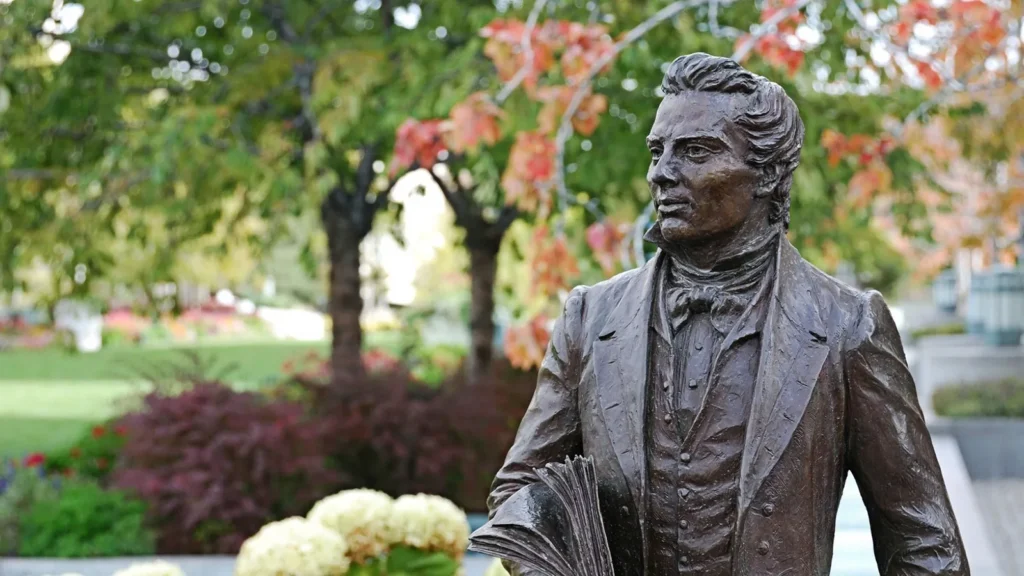
FAIR is a non-profit organization dedicated to providing well-documented answers to criticisms of the doctrine, practice, and history of The Church of Jesus Christ of Latter-day Saints.
FAIR › Scripture Study Resources: Supplement Your Come, Follow Me Study › Study Resources for the Doctrine & Covenants and Church History › Week 13 All Things Must be Done in Order

In Doctrine and Covenants 27:2, the Lord teaches that it does not matter what is used as the emblem of the sacrament, as long as it is partaken with an “eye single to [His] glory.” This emphasizes that the focus of the sacrament is not on the physical elements but on our spiritual commitment to Christ.
The Lord’s instruction to Joseph Smith about the sacrament in Doctrine and Covenants 27:1–4 underscores that it is a moment of personal worship and renewal. By preparing for and approaching the sacrament with reverence, we can deepen our relationship with the Savior and better retain a remission of our sins.
In Doctrine and Covenants 28:2, the Lord states that only the President of the Church is appointed to receive revelation for the entire Church. This was a necessary clarification when Hiram Page mistakenly believed he had received revelation for the Church, helping the Saints understand the proper channels for divine guidance.
In Doctrine and Covenants 28:15, the Lord assures Oliver Cowdery that he will be guided in his responsibilities, demonstrating that revelation is not limited to the prophet but is given according to one’s stewardship. This principle helps members navigate their personal discipleship while upholding unity in the Church.
Doctrine and Covenants 27:15–18 describes the “armor of God” as essential protection against evil. President M. Russell Ballard taught that spiritual fortification is not a single grand event but a series of small, consistent acts of faith, such as daily prayer, scripture study, and obedience.
The breastplate of righteousness protects our hearts—our desires and intentions—while the helmet of salvation guards our thoughts and understanding of Christ’s role in our lives. By actively applying these principles, we become more resilient against temptation and deception.
The Lord clarified that only the prophet—at that time, Joseph Smith—was appointed to receive revelation for the entire Church (Doctrine and Covenants 28:2). This event helped establish a foundational doctrine of Church governance: the principle of prophetic authority. While all members can receive personal revelation, the Lord’s house is “a house of order” (Doctrine and Covenants 28:13), and Church-wide direction comes through His appointed prophet.
Understanding the proper channels of revelation helps members today stay anchored in true doctrine and avoid deception. Just as early Saints needed guidance to discern between personal inspiration and divine instruction for the Church, we too must rely on prophetic authority while seeking personal revelation within our own stewardships.
If you have questions on this week’s reading, please email your questions to us here.
Practical solutions for someone in faith crisis:
Action Step: Prepare for the sacrament by studying Christ’s Atonement and examining your personal commitment to Him.
The sacrament is an opportunity to renew covenants and draw closer to the Savior. By approaching it with greater reverence, we can experience increased spiritual strength and a deeper sense of peace.
Encouraging Thought:
Action Step: Develop a habit of writing down spiritual impressions and acting on them.
The Lord has established order in revelation—Church-wide direction comes through the prophet, but personal guidance is available to all. Learning to discern and act on revelation strengthens our faith and deepens our relationship with God.
Encouraging Thought:
The world presents constant spiritual challenges, and without intentional effort, we can become vulnerable to doubt, temptation, or discouragement. By strengthening our defenses, we stay rooted in truth and righteousness.
Encouraging Thought:
President M. Russell Ballard taught, “True spiritual power lies in numerous smaller acts woven together in a fabric of spiritual fortification that protects and shields from all evil” (“Be Strong in the Lord,” Ensign, July 2004).
Objective: Help learners understand the importance of the armor of God and how to apply it in daily life.
Paper, pens, printed images of armor, Doctrine and Covenants 27:15–18, Ephesians 6:11–18.
Follow-Up Question: Which piece of the armor of God do you feel you need the most right now, and why?
Objective: Clarify the order of revelation in the Church and how personal revelation works.
A leadership flowchart (showing prophet, apostles, local leaders, and individuals), Doctrine and Covenants 28:1–7, “A Framework for Personal Revelation” (Elder Renlund).
Follow-Up Question: How can we ensure that our personal revelation aligns with God’s established order?
Objective: Deepen understanding of the sacrament’s meaning and how it helps us draw closer to Christ.
Journals or paper, Doctrine and Covenants 27:1–4, sacrament hymn lyrics (such as “As Now We Take the Sacrament”).
Follow-Up Question: What is one thing you can do before Sunday to prepare spiritually for the sacrament?
Why Trust Modern Prophets?

FAIR is a non-profit organization dedicated to providing well-documented answers to criticisms of the doctrine, practice, and history of The Church of Jesus Christ of Latter-day Saints.
We are a volunteer organization. We invite you to give back.
Donate Now